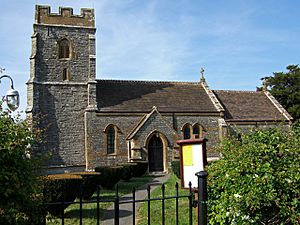Church of St Peter, South Barrow facts for kids
Quick facts for kids Church of St Peter |
|
|---|---|
 |
|
| Location | South Barrow, Somerset, England |
| Built | 14th century |
|
Listed Building – Grade II*
|
|
| Official name: Church of St Peter | |
| Designated | 24 March 1961 |
| Reference no. | 1258889 |
| Lua error in Module:Location_map at line 420: attempt to index field 'wikibase' (a nil value). | |
The Church of St Peter is an Anglican church located in South Barrow, a village in Somerset, England. This historic church was built a very long time ago, in the 14th century. It is recognized as a Grade II* listed building, which means it's a very important historical building that needs to be protected.
Contents
A Look Back: Church History
When Was the Church Built?
The Church of St Peter was likely built in the 14th century, or perhaps even earlier. Imagine how many generations have worshipped here! In 1850, the church had a big update. This was part of a "Victorian restoration," which means it was repaired and improved during the time Queen Victoria ruled. During this time, a new part called the chancel was added.
A Church for the Community
For a while, the church wasn't used very much. But thanks to a grant of £20,000 from the Somerset Community Foundation, the inside of the church was changed. These changes made the space more flexible. Now, the church can be used for many different community activities, not just church services. This helps the church serve the people of South Barrow in new ways.
Part of a Larger Group
The Church of St Peter is part of a group of churches called the Six Pilgrims benefice. This group belongs to the Diocese of Bath and Wells. A diocese is like a large area managed by a bishop in the Anglican Church.
Church Design: What It Looks Like
Building Materials and Shape
The church is made of stone and has roofs covered with clay tiles. It has a main area called the nave, which is divided into three sections or "bays." There's also a chancel with two bays. These parts are supported by strong structures called buttresses, which help hold up the walls. The church also has a two-stage tower, which is also supported by buttresses.
Inside the Church
Even though the church was updated in the 19th century, you can still see some original parts. There are arches from the 13th or 14th century. Most of the inside, however, looks like it was designed in the 1800s. Some older pieces of furniture remain. The altar table, the pulpit (where the priest gives sermons), and the sexton's desk are from the 17th century. The font, which is used for baptisms, has the date 1584 carved on it.
Remembering the Past
Inside the church, there is a special brass plaque. This plaque remembers the brave men from the village who lost their lives during World War I. It's a way to honor their memory and sacrifice.
See also
- List of ecclesiastical parishes in the Diocese of Bath and Wells

